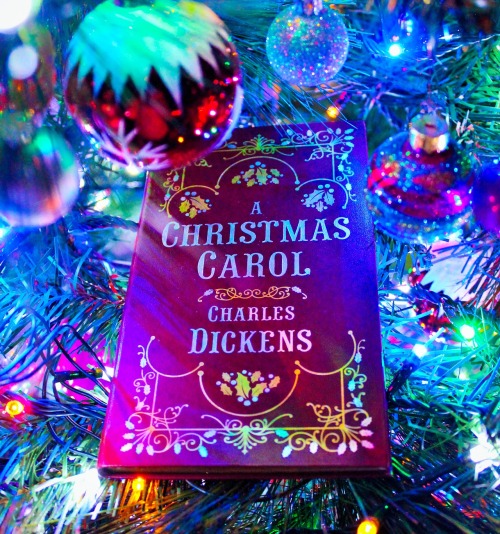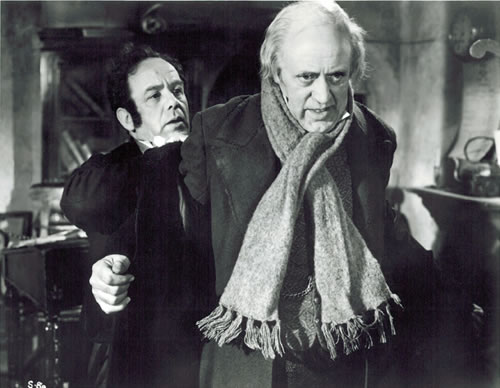Variations on the same theme: Scrooge (1935) and A Christmas Carol (1951)
Para os cristãos, o Natal é o dia de se comemorar
o nascimento de Jesus, e todo o mês de dezembro acaba entrando na órbita da
festa natalina. Mesmo as pessoas de outra religião acabam sendo contagiadas
pelo espírito de Natal e acontecem as confraternizações, trocas de presentes e
todos ficam com o coração mais mole, ajudando uns aos outros e desejando o bem
do próximo (pelo menos é isso que eu gostaria que acontecesse). Todos, menos
Ebenezer Scrooge, personagem criado por Charles Dickens que se tornou o símbolo
do Natal inglês - e da avareza.
For christians, Christmas
is the date to celebrate Jesus's birthday, and the whole month of December
enters the Christmas spirit. Even people from other religions are contaminated
by Christmas spirit and we have parties, gifts and all people become more
lovable, helping each other and wishing only the best (at least that's what I
wish that happened). All people, except Ebenexer Scrooge, a character created
by Charles Dickens and one who became the symbol of the English Christmas – and
of greed.
Ebenezer Scrooge (Seymour Hicks em 1935 e Alastair Sim em
1951) é o rabugento sócio da companhia Scrooge & Marley. Jacob Marley, o
co-proprietário, morreu na véspera de Natal, sete anos antes do começo da
história. Mas não é esse o motivo de Scrooge detestar o Natal: o tempo e a
ganância fizeram dele uma pessoa amarga, que não gosta de nada. Ele vê o Natal
como uma perda de tempo para os negócios e uma desculpa para que as
instituições de caridade peçam dinheiro. Por isso Scrooge se recusa a ajudar
dois representantes de uma instituição e também não dá folga para seu
funcionário Bob Cratchit no dia de Natal.
Ebenezer Scrooge (Seymour Hicks
in 1935 and Alastair Sim in 1951) is the grumpy partner in the company Scrooge
& Marley. Jacob Marley, the other partner, died on Christmas Eve, seven
years before our story begins. But it's not because of this fact that Scrooge
hates Christmas: time and greed turned him into a bitter person, one who lieks
absolutely nothing. He sees Christmas as a waste of time for business and an
excuse for charity institutions to beg for donations. That's why Scrooge
refuses to help two men from a charity institution, and he also refuses to give
a day off to his employee Bob Cratchit on Christmas Day.
Naquela noite, Scrooge é visitado pelo fantasma
de seu sócio, que o aconselha a mudar seu comportamento. Para ver a importância
desta mudança, serão mandados três espíritos de Natal para Scrooge ao longo da
noite: o espírito dos Natais passados, o do Natal presente e o do Natal futuro.
Através da viagem com esses espíritos pelo tempo e espaço, Scrooge verá não
apenas fatos importantes da sua vida que mostram sua amargura, mas também
conhecerá melhor aqueles que o rodeiam.
That night, Scrooge is
visited by the ghost of his partner, and he is advised to change his behavior.
To show the important of this change, three spirits will be sent to Scrooge
throughout the night: the spirit of Christmas Past, the spirit of Christmas
Present and the spirit of Christmas Yet to Come. During the trip with these
spirits through space and time, Scrooge will see not only important facts of
his life – that ones that shaped his grumpiness – but he'll also get to know
better the people around him.
Ambas as versões são bem fiéis ao livro. A de
1935 (“Scrooge”) tem várias falas retiradas diretamente da obra de Dickens, mas
é limitada quanto aos efeitos dos fantasmas - apenas o espírito do Natal
presente aparece por completo, os demais são apenas vozes e sombras. A de 1951 (“A Christmas Carol”) esbanja tecnologia: o intérprete do fantasma de Marley
não pôde gravar as cenas com Alastair Sim, por isso gravou-as sozinho e sua
imagem foi sobreposta às cenas de Alastair, ficando assim mais fantasmagórica.
Entretanto, esta versão toma algumas liberdades e acrescenta cenas, deixando-a
mais longa, mas também mais emocionante.
Both versions foloow the
book closely. “Scrooge”, from 1935, has a lot of quotes taken directly from
Dickens's work, but it uses limited technology to portray the ghosts – only
thte spirit of Christmas Present is fully shown, the others are only voices and
shadows. “A Christmas Carol”, from 1951, is very technological: the actor who
portrays Marley's ghost wasn't able to shoot the scenes with Alastair Sim, só
he shot them alone and his image was superposed to Alastair's scenes, giving a
more fantasmagoric tone to it. However, this version takes on some liberties
and adds some scenes, that's why it's longer, but also more moving.
Seymour Hicks já havia interpretado Scrooge em
1913, em uma das primeiras versões cinematográficas da história. Ele também
interpretava o personagem no teatro desde 1901, que, por coincidência, foi o
ano em que surgiu a primeira adaptação para o cinema do conto escrito por
Dickens em 1843. Seymour pode ter tradição, mas foi Alastair que eternizou o
personagem. De fato, Ebenezer Scrooge definiu sua carreira. As expressões
faciais de Alastair são excelentes, em especial no fim - adoro a cena “I need
to stand on my head!”. Alastair voltaria a encarnar o personagem em desenho
animado, pois foi o dublador de Scrooge em um curta-metragem ganhador do Oscar
em 1971.
Seymour Hicks had already
played Scrooge in 1913, in one of the first screen adaptations of the story. He
also played the character on stage since 1901, the year in which Dickens's
story, written in 1843, was first adapted to film. Seymour may have had the
tradition on his side, but it was Alastair who personified Scrooge. Indeed, the
character Scrooge defined his career. Alastair's facial expressions are priceless,
especially in the end – I love the scene “I need to stand on my head!”.
Alastari once more played Scrooge in a cartoon: he dubbed Scrooge in an
Osdcar-winning animated short in 1971.
Já disse que a versão de 1951 é mais emocionante,
certo? Isso acontece porque as mudanças na história original foram feitas para
justificar sempre as ações de Scrooge, fazendo dele uma vítima de seu mentor,
Mr Jorkin (Jack Warner). Surpreendentemente, nos Estados Unidos o filme não foi
bem recebido, tendo estreado no Halloween e gerado pouco interesse no público.
I told you all that the
1951 version is more moving, right? This happens because changes in the
original story were made to always justify Scrooge's actions, in a sense that he was a victim of his mentor, Mr Jorkin
(Jack Warner). Surprisingly, in the US the film was not well-received because
it premiered on Halloween and few people went to see it.
Além das várias adaptações (o IMDb lista 95) , a
obra de Dickens deixou outros legados. “Scrooge” se tornou sinônimo de
“avarento, sovina” nos países de língua inglesa. Esse significado serviu para
batizar um personagem da Disney: o tio Patinhas, ou Uncle ScroogeMcDuck. A
exclamação de Scrooge logo ao início (“bah... Humbug!”), que infelizmente é
dita apenas uma vez na versão de 1951, ressuscitou recentemente graças a um dos
gatos mais famosos da internet: Grumpy Cat.
Besides the many
adaptations (IMDb lists 95 of them), Dickens's work left other legacies.
'Scrooge' became a synonym of 'stingy' in English-speaking countries. This
meaning was taken in consideration to baptize a Disney character: Uncle Scrooge
McDuck. Scrooge's exclamation right in the beginning (“bah...Humbug!”),
unfortunately said only once in the 1951 version, was resurrected thanks to one
of internet's most famous felines: Grumpy Cat.
A primeira vez em que Scrooge apareceu no cinema
foi em 1901, em um curta surpreendentemente bom, apesar de os fantasmas serem
atores com lençóis na cabeça. Claro que Thomas Edison não poderia ficar para
trás e fez sua versão em 1910. Apesar de o silêncio prejudicar um pouco a
história, precisamos destacar a qualidade dos efeitos especiais criados. No
rádio a história também foi bastante popular, e quem fazia o papel de Scrooge era Lionel Barrymore. Na televisão, há que se destacar a versão de 1949, narrada pela bela
voz de Vincent Price.
Scrooge's film debut was
in 1901, in a surprisingly good short film, even though we have here ghosts
that were actors with sheets on their heads. Thomas Edison, of course, had to
make his own version in 1910. The silence may be bad for the overall quality of
the movies, but we must point that the special effects are outstanding. In
radio the story was also very popular, and who played Scrooge was Lionel Barrymore. In television, we must point out the 1949 version, narrated by
Vincent Price's beautiful voice.
Clique nas palavras e números em negrito para ver
os filmes completos!
Click the words and numbers in bold to watch the full
movies!
This is my contribution to the Christmas Movie Blogathon, hosted by
Chris and Family Friendly Reviews. Ho, ho, ho!
Eu volto antes do Natal, mas deixo vocês com uma
foto da minha árvore inspirada no cinema (cliquem para ver melhor os detalhes)!
I'll be back before
Christmas, but for now you can see my film-inspired Christmas tree (click to
see all the details)!



.jpg)



10 comments:
minha mãe ama natal e filmes de natal. tem vários, assiste tudo o q aparece. beijos, pedrita
Esse conto de natal já vi em inumeras versões até mesmo na saudosa tv colosso.
Quando era pequeno, todo o final de ano dava a Rena do Nariz Vermelho. Bons tempos.
Só assisti a versão do Jim Carey, em animação. As versões "vintage" eu ainda não vi - mas, boa dica para se assistir no Natal.
Beijos <3
P.S: Com a morte da Joan Fontaine, pq vc não faz um tribute post para ela? Era uma diva....sei lá, é só uma ideia.
I think someone could almost do a blogathon just on Christmas Carol versions--and these are great ones!
Feliz Natal! :)
A very Merry Christmas to you!
I adore your tree. Enjoyed your look at "A Christmas Carol", particularly the two versions you chose to highlight. Sim's is the very top one for me. I have watched it every Christmas Eve since I was a very little girl. I only became familiar with Seymour Hicks' version a couple of years ago and it is very impressive. He truly gave us a Scrooge who was the meanest man in town.
Great article! I learned some interesting trivia about the movies that I didn't know before. I love "Christmas Carol."
Wonderful comparison between two greats, Le. Like most others, the 1952 version is my absolute favorite, but I try to watch a few versions of this story every year.
A very Merry Christmas to you and yours!! Such a great year this turned out to be as I got to know some of my blogging friends a bit better.
Aurora
I enjoyed your post! I've never seen the 1935 Seymour Hicks version so was interested to learn more -- TCM just showed it and I recorded it!
One of my favorite versions is the Disney MICKEY'S CHRISTMAS CAROL with Scrooge McDuck -- it's so cute! I watched it last Christmas. :)
Merry Christmas!
Best wishes,
Laura
Definitely need to check out the 1951 version of A Christmas Carol before next year!
Post a Comment